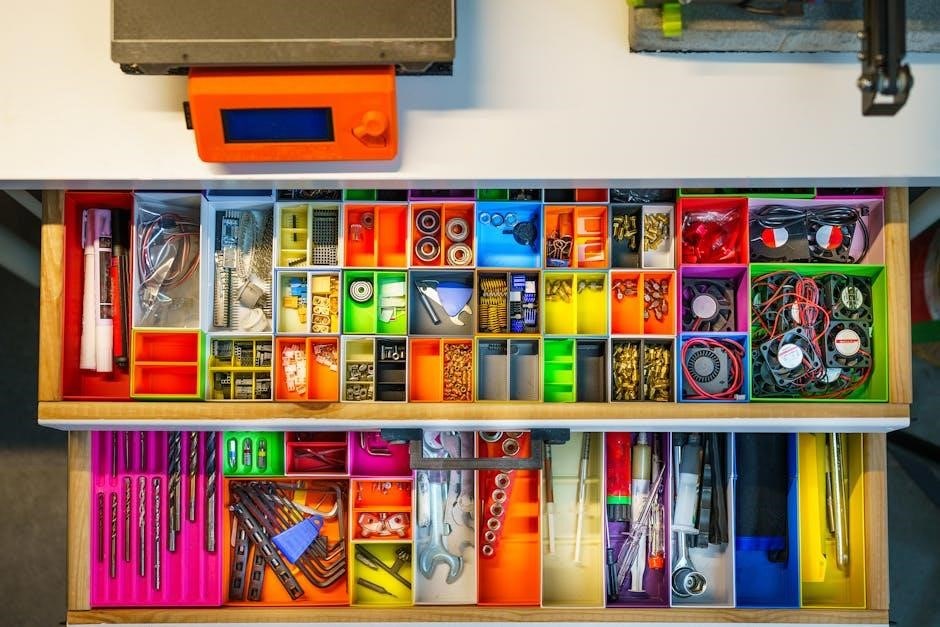The PADI Open Water Diver Manual, authored by International PADI, Inc․ in 2008, serves as the primary educational resource for the Open Water Diver course․ Available in PDF format, this comprehensive guide provides foundational knowledge and practical skills essential for safe and confident diving․
1․1 Overview of the PADI Open Water Diver Course
The PADI Open Water Diver course is the foundational program for individuals seeking to become certified scuba divers․ Designed for beginners, it equips students with essential knowledge and practical skills to dive safely and confidently․ The course structure includes both theoretical learning and hands-on training, ensuring a comprehensive understanding of diving principles, safety protocols, and equipment usage․ Students progress through a series of modular sessions, combining classroom instruction with confined water practice and open water dives․ Upon completion, participants earn the PADI Open Water Diver certification, granting them the ability to dive independently within safe depth limits․ This course is a critical first step for anyone aspiring to explore the underwater world, emphasizing safety, skill development, and environmental awareness․
1․2 Key Features of the Manual
The PADI Open Water Diver Manual is a detailed, user-friendly guide designed to support the learning process for new divers․ It includes comprehensive chapters on diving fundamentals, safety procedures, and equipment usage․ The manual incorporates high-quality visuals, diagrams, and illustrations to enhance understanding of complex concepts․ Key features also include practical exercises, quizzes, and assessments to reinforce theoretical knowledge․ Additionally, the manual emphasizes environmental awareness and responsible diving practices․ Available in multiple formats, including PDF, it offers flexibility for learners to study at their own pace․ The manual is structured logically, ensuring a progressive and thorough approach to mastering diving skills․ Its clear and concise language makes it accessible to a wide audience, while its robust content ensures a solid foundation for future diving adventures․
1․3 Importance of the Manual for Diver Certification
The PADI Open Water Diver Manual is a critical resource for achieving diver certification, as it provides the necessary knowledge and skills required to become a competent diver․ The manual serves as the foundation for the Open Water Diver course, ensuring that participants understand safety protocols, diving techniques, and environmental considerations․ It equips learners with the theoretical knowledge needed to pass the certification exams and practical assessments․ By following the manual, divers can reduce risks and ensure safe diving practices․ The structured content aligns with PADI’s high standards, making it indispensable for both instructors and students․ Completion of the manual’s exercises and assessments is a mandatory step toward obtaining the PADI Open Water Diver certification, which is recognized worldwide․ This manual is essential for building confidence and competence in diving, making it a vital tool for aspiring divers․

Course Structure and Curriculum
The PADI Open Water Diver course is structured into modules, combining classroom sessions, theoretical learning, and practical training in confined and open water environments, ensuring comprehensive skill development․

2․1 Modular Breakdown of the Course
The PADI Open Water Diver course is divided into three main phases: knowledge development, confined water training, and open water dives․ Each module is designed to progressively build skills and confidence․ The knowledge development phase introduces foundational concepts through the PADI Open Water Diver Manual, covering topics like diving physics, safety procedures, and equipment usage․ This phase is completed independently, with quizzes to ensure understanding․ The confined water training phase allows divers to practice skills in a controlled environment, such as a swimming pool, under the supervision of a PADI instructor․ Finally, the open water dives phase applies these skills in real-world conditions, typically over four dives, focusing on navigation, buoyancy, and emergency procedures․ This modular structure ensures a thorough and safe learning experience, preparing students for independent diving․
2․2 Classroom Sessions and Theoretical Learning
The PADI Open Water Diver course includes classroom sessions that complement the manual, focusing on theoretical aspects of diving․ These sessions cover essential topics such as diving physics, physiology, and safety procedures․ Through lectures and interactive discussions, students gain a deeper understanding of how pressure affects the body underwater, gas laws, and emergency protocols․ The PADI Open Water Diver Manual serves as the primary textbook, with chapters dedicated to these subjects; Quizzes and exams are administered to ensure comprehension before progressing to practical training․ This theoretical foundation is crucial for safe and confident diving, as it prepares students to apply knowledge in real-world scenarios during confined and open water training․ The structured learning approach ensures that all concepts are thoroughly understood, making the transition to practical skills seamless and effective;
2․3 Practical Training and Dive Sessions
Practical training and dive sessions are the hands-on component of the PADI Open Water Diver course, where students apply the knowledge gained from the manual․ These sessions are conducted in a controlled environment, such as a swimming pool or confined water, before progressing to open water dives․ Under the supervision of a PADI instructor, students practice essential skills like equipment setup, buoyancy control, and underwater navigation․ Specific techniques, such as mask clearing, regulator recovery, and emergency ascent procedures, are mastered during these sessions․ The practical training emphasizes safety, proper diving practices, and confidence building․ Each skill is demonstrated and repeated until proficiency is achieved․ These dives are structured to gradually introduce students to real-world diving conditions, ensuring they are well-prepared for independent diving after certification․ The practical component reinforces theoretical concepts, making the learning experience comprehensive and effective․

Safety Procedures and Protocols
The PADI Open Water Manual emphasizes essential safety procedures and protocols, such as buddy checks, emergency protocols, and risk assessment, promoting safe diving practices and accident prevention strategies to ensure diver well-being․
3․1 Essential Safety Guidelines for Divers
The PADI Open Water Manual outlines critical safety guidelines to ensure safe diving practices․ These include pre-dive safety checks, such as testing equipment and assessing environmental conditions․ Divers are taught to always dive with a buddy, maintaining clear communication and monitoring each other’s air supply and depth limits․ The manual emphasizes the importance of staying within personal and certification limits to avoid risks․ Additionally, it covers proper ascent and descent techniques to prevent injuries and decompression sickness․ Divers are also advised to carry signaling devices and know emergency protocols․ By following these guidelines, divers can minimize hazards and enjoy a safer, more enjoyable underwater experience․ These practices are foundational for responsible and confident diving․
3․2 Emergency Procedures and Response Plans
The PADI Open Water Manual provides detailed emergency procedures and response plans to ensure divers are prepared for unexpected situations․ These include protocols for buddy separation, low on air scenarios, and diver panic․ The manual emphasizes the importance of staying calm and following structured steps, such as signaling for help and initiating ascent procedures․ It also covers the use of safety equipment, like safety sausages or underwater signaling devices, to alert others․ Proper emergency response includes knowing when to seek assistance and how to assist a distressed diver․ The manual also outlines the role of first aid and CPR in diving emergencies․ These procedures are designed to minimize risks and ensure a safe resolution to critical situations, reinforcing the importance of preparedness in diving safety․
3․3 Risk Management and Mitigation Strategies
Risk management is a critical component of safe diving practices, as outlined in the PADI Open Water Manual․ The manual teaches divers to identify potential hazards and implement strategies to minimize risks․ This includes conducting thorough site assessments, planning dives according to individual skill levels, and staying within safe depth and time limits․ Divers learn to assess environmental factors, such as currents and visibility, and adapt their plans accordingly․ The manual also emphasizes the importance of proper equipment checks and the buddy system to enhance safety․ By understanding and applying these risk management strategies, divers can reduce the likelihood of incidents and ensure a safer, more enjoyable diving experience․ Proper planning and awareness are key to balancing excitement with responsibility underwater․

Equipment Usage and Maintenance
The PADI Open Water Manual emphasizes proper equipment usage and maintenance to ensure safety, longevity, and reliability․ Divers learn to inspect, clean, and store gear effectively, preparing them for underwater conditions․
4․1 Overview of Scuba Diving Equipment
The PADI Open Water Manual provides a comprehensive overview of scuba diving equipment, ensuring divers understand each component’s purpose and function․ Key items include the scuba tank, regulator, BCD (buoyancy control device), wetsuit or dry suit, mask, snorkel, and fins․ The manual explains how these pieces work together to enable safe and efficient diving․ It also covers accessories like dive computers, underwater lights, and safety devices, highlighting their roles in enhancing the diving experience․ Understanding this equipment is crucial for divers to maintain safety, comfort, and control underwater․ The manual emphasizes the importance of proper fitting and compatibility to ensure optimal performance․ This foundational knowledge prepares students for practical training and real-world diving scenarios․
4․2 Proper Usage and Care of Diving Gear
Proper usage and care of diving gear are essential for safety, performance, and longevity․ The PADI Open Water Manual emphasizes following manufacturer guidelines for equipment operation․ Pre-dive checks are critical to ensure all components function correctly, such as inspecting hoses, connections, and inflators․ After diving, gear should be rinsed with fresh water to remove salt, dirt, and chemicals, which can cause corrosion․ Storage in a cool, dry place, away from direct sunlight, prevents degradation․ Regular lubrication of moving parts, like regulator valves, maintains smooth operation․ Avoiding harsh chemicals and abrasive materials protects the equipment․ Proper assembly and disassembly techniques prevent damage․ Regular maintenance ensures gear remains reliable, reducing the risk of failure underwater․ By adhering to these practices, divers can extend the life of their equipment and ensure safe, enjoyable dives․ This section underscores the importance of meticulous care in preserving diving gear for optimal performance․
4․3 Maintenance Tips for Longevity and Safety
Regular maintenance of diving gear is crucial for ensuring longevity and safety․ The PADI Open Water Manual highlights the importance of professional servicing for complex equipment like regulators and BCDS annually or every 100 dives․ O-rings and hoses should be inspected and replaced as needed to prevent leaks․ Batteries in dive computers and torches should be changed regularly to avoid sudden failure․ Corroded metal parts must be cleaned or replaced to maintain integrity․ Dive bags and storage containers should protect gear from dust and pests․ Logging maintenance in a dedicated record helps track service history․ Adhering to these tips ensures equipment remains reliable, reducing risks during dives․ Proper maintenance not only extends the life of diving gear but also enhances safety, making it a vital part of responsible diving practices․ Following these guidelines ensures divers can rely on their equipment in critical situations․

Diving Techniques and Skills
Mastering essential diving techniques enhances safety and enjoyment underwater․ This section covers buoyancy control, navigation, and communication, ensuring divers develop the skills needed for confident and efficient diving․

5․1 Mastering Buoyancy Control
Buoyancy control is a fundamental skill in scuba diving, enabling divers to maintain a stable depth with minimal effort․ The PADI Open Water Manual emphasizes techniques like breathing naturally, using the BCD effectively, and adjusting weight belts․ Proper buoyancy prevents excessive air consumption, reduces environmental impact, and enhances underwater comfort․ Divers learn to ascend and descend gradually, avoiding rapid changes that could cause discomfort or injury․ The manual also covers the use of buoyancy control devices (BCDs) and how to fine-tune buoyancy during the dive․ Mastering this skill is critical for safe and enjoyable diving experiences, allowing divers to hover effortlessly and conserve energy․
5․2 Navigation Techniques Underwater
Underwater navigation is a critical skill for scuba divers to ensure safety and efficiency during dives․ The PADI Open Water Manual teaches divers to use natural navigation cues, such as underwater landmarks, depth contours, and the position of the sun․ Compass navigation is also covered, emphasizing how to use a dive compass to maintain direction and return to the starting point․ Divers learn techniques like the “reciprocal heading” to navigate back to their origin․ Additionally, the manual highlights the importance of estimating distance underwater, which can be challenging due to water’s refractive properties․ By mastering these techniques, divers can avoid disorientation, stay within designated areas, and enhance their overall diving experience․ Proper navigation also helps in conserving energy and ensuring a safe ascent․
5․3 Effective Underwater Communication
Effective underwater communication is vital for safe and enjoyable diving experiences․ The PADI Open Water Manual emphasizes the use of standardized hand signals to convey messages clearly․ Common signals include “okay,” “stop,” “go up,” and “low on air,” ensuring all divers understand each other․ Body language also plays a role, as divers can use gestures to express emotions or intentions․ Additionally, divers are taught to stay within sight of their buddies to maintain visual communication․ The manual highlights the importance of pre-dive planning, where signals and protocols are agreed upon․ This ensures that all team members are aligned and can respond appropriately during the dive․ Proper communication helps prevent misunderstandings, enhances safety, and fosters a more enjoyable experience for everyone involved in the dive․ Clear and concise signaling is a cornerstone of successful underwater interactions․

Environmental Considerations
The PADI Open Water Manual highlights the importance of marine conservation and sustainable diving practices to protect ecosystems and promote environmental awareness among divers․
6․1 Marine Conservation and Diver Impact
The PADI Open Water Manual emphasizes the vital role divers play in marine conservation․ It highlights how diving activities, while recreational, can impact marine ecosystems․ Touching coral reefs, disturbing wildlife, or causing sediment stirred by fins can damage habitats and disrupt marine life․ The manual underscores the importance of sustainable diving practices to minimize these effects․ By adopting a “look-but-don’t-touch” approach, divers can help preserve coral reefs and protect marine biodiversity․ Additionally, the manual encourages divers to participate in marine conservation efforts, such as cleaning up underwater debris or supporting local environmental initiatives․ Understanding the impact of their actions empowers divers to become stewards of the ocean, balancing the enjoyment of diving with the responsibility to protect marine life and ecosystems for future generations․ This section reinforces ethical diving practices to ensure the preservation of marine environments․
6․2 Environmental Awareness for Divers
Environmental awareness is a cornerstone of the PADI Open Water Diver program, teaching students to recognize and respect the delicate balance of marine ecosystems․ The manual highlights how human activities, including diving, can inadvertently harm the environment․ It emphasizes the importance of understanding local marine life, avoiding contact with coral reefs, and not disturbing wildlife․ Divers are encouraged to adopt eco-friendly practices, such as securing diving gear to prevent entanglement and avoiding the use of chemical sunscreens that harm coral․ By fostering a deeper appreciation for the underwater world, the manual inspires divers to become advocates for marine conservation․ This section underscores the role of divers in protecting marine biodiversity and promotes sustainable diving practices to preserve the beauty and health of oceans for future generations․ Awareness is key to minimizing the environmental footprint of diving activities․
6․3 Local and International Diving Regulations
Understanding local and international diving regulations is crucial for every diver, as outlined in the PADI Open Water Manual․ These rules are designed to protect both divers and the environment․ Local regulations often include restrictions on diving in protected areas, requirements for permits, and guidelines for interacting with marine life․ Internationally, agreements such as the Convention on International Trade in Endangered Species (CITES) regulate the removal of marine species․ Divers must comply with these laws to avoid legal consequences and ensure sustainable diving practices․ The manual emphasizes the importance of respecting local customs, environmental policies, and international diving standards․ By adhering to these regulations, divers contribute to the preservation of marine ecosystems and uphold the ethical principles of the PADI Open Water Diver program․ Staying informed about these rules is essential for responsible and safe diving experiences worldwide․ Compliance ensures both personal safety and environmental protection․

Certification Process and Requirements
The PADI Open Water certification requires completing all course modules, passing final exams, and demonstrating proficiency in practical diving skills․ Safety and adherence to PADI standards are paramount․
7․1 Steps to Obtain PADI Certification
The certification process begins with completing the classroom and confined water training sessions․ Divers must pass quizzes and a final exam to demonstrate understanding of safety procedures and diving principles․ Practical skills are assessed during confined water dives, ensuring mastery of essential techniques․ Once these requirements are met, students proceed to open water dives, where they apply their knowledge and skills in real diving conditions․ Successful completion of all these steps, along with a medical questionnaire and dive logs, leads to PADI Open Water certification․ Instructors guide students through each step, providing feedback and ensuring adherence to safety standards․ This structured approach guarantees that divers are well-prepared and confident for independent diving experiences worldwide․
7․2 Prerequisites and Eligibility Criteria
To enroll in the PADI Open Water Diver course, candidates must meet specific eligibility criteria․ The minimum age requirement is 15 years old for the standard certification, though a Junior Open Water Diver program is available for those aged 10 to 14․ Prospective divers must complete a medical questionnaire, and certain health conditions may require approval from a physician․ Additionally, candidates must possess basic swimming skills, including the ability to swim 200 meters without assistance and tread water for 10 minutes․ These prerequisites ensure that participants are physically and mentally prepared for the demands of scuba diving․ Meeting these criteria is essential for safe and effective training, as they align with PADI’s safety standards and operational guidelines․
7․3 Post-Certification Guidance and Next Steps
After obtaining PADI Open Water certification, divers receive guidance on continuing their diving journey․ The manual emphasizes the importance of logging dives and staying updated on safety protocols․ Divers are encouraged to explore specialty courses, such as Deep Diver or Night Diver, to enhance their skills․ Additionally, the PADI Advanced Open Water Diver certification is recommended for further development․ The manual also highlights the value of joining diving communities and participating in conservation efforts; Continuous education and experience are key to becoming a confident and proficient diver․ By following these steps, newly certified divers can expand their knowledge, improve their techniques, and enjoy a lifetime of safe and rewarding diving experiences․

Additional Resources and Support
The PADI Open Water Manual PDF offers supplementary materials, online resources, and community support to enhance learning and diving experiences, ensuring continuous education and skill improvement for divers․
8․1 Supplementary Learning Materials
The PADI Open Water Manual PDF is complemented by a range of supplementary learning materials designed to reinforce concepts and enhance understanding․ These include detailed workbooks, logbooks, and interactive digital content․ Additionally, divers can access quizzes, diagrams, and videos that align with the manual’s curriculum․ These resources are tailored to different learning styles, ensuring a comprehensive grasp of diving principles․ For example, the PADI Open Water Diver Manual is often paired with the PADI Open Water Diver Video, which visually demonstrates key skills and safety procedures․ Supplementary materials also cover advanced topics, such as underwater navigation and buoyancy control, in greater depth․ These tools are accessible in both physical and digital formats, making them convenient for on-the-go study․ By utilizing these resources, students can deepen their knowledge and prepare effectively for both theoretical and practical assessments․ This integrated approach ensures a well-rounded education for new divers․
8․2 Online Resources and Community Support
Beyond the PADI Open Water Manual PDF, divers can access a wealth of online resources and community support to enhance their learning experience․ PADI offers an official eLearning platform, where students can complete coursework, review materials, and interact with instructors virtually․ Additionally, online forums, social media groups, and specialized diving communities provide spaces for divers to ask questions, share experiences, and gain insights from certified professionals․ Many local dive shops also host webinars and workshops, further supporting diver education․ These resources not only supplement the manual but also foster a sense of belonging within the diving community․ By leveraging these tools, students can deepen their understanding of diving principles and stay connected with fellow divers worldwide․ This comprehensive support system ensures that learners have access to guidance and knowledge beyond the manual itself․
8․3 Continuous Education and Specializations
After completing the PADI Open Water Diver certification, the PADI Open Water Manual PDF encourages students to pursue continuous education and specializations to enhance their diving skills․ PADI offers a range of advanced courses, such as the Adventure Diver and Rescue Diver programs, which allow divers to explore specialized areas like deep diving, wreck diving, or underwater photography․ These courses are designed to build confidence and expertise in specific diving environments․ Additionally, the PADI eLearning platform provides access to materials for advanced certifications, enabling divers to progress at their own pace․ Continuous education not only improves diving abilities but also fosters a deeper appreciation for marine environments․ By pursuing specializations, divers can tailor their training to match their interests and career goals, ensuring a lifelong journey of learning and growth in the world of scuba diving․ This pathway supports both recreational and professional aspirations․


















































